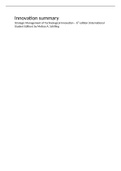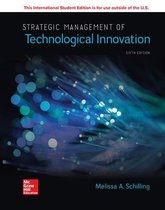Innovation summary
Strategic Management of Technological Innovation – 6th edition (International
Student Edition) by Melissa A. Schilling
,Index
- Chapter 1
- Chapter 2
- Chapter 3 (excluding technology s-curves)
- Chapter 7 (excluding real options)
- Chapter 11
- Article: Portfolio management for new product development: results of an industry
practices study
- Chapter 8
- Chapter 10 (excluding managing innovation across borders)
- Chapter 12
- Article: Critical functions: needed roles in the innovation process
- Chapter 3 part on technology s-curves
- Chapter 4
- Chapter 5
- Chapter 13
- Chapter 10 part on managing innovation across borders
- Article: How smart, connected products are transforming competition
,CHAPTER 1 – Importance of innovation
Technological innovation = the act of introducing a new device, method, or material for
application to commercial or practical objectives
Impact of technological innovation on society
1. GDP
2. Negative externalities
3. Knowledge to solve our problems and pursue our goals
Gross domestic product (GDP) = the total annual output of an economy as measured by its
final purchase price
Externalities = costs (or benefits) that are borne (or reaped) by individuals other than those
responsible for creating them
Innovation funnel = inventors may develop many new devise or processes but
commercialize few, most innovative ideas do not become successful new products
CHAPTER 2 – Sources of innovation
Innovation = the practical implementation of an idea into a new device or process
Idea = something imagined or pictured in the mind
Creativity = the ability to produce novel and useful work
Individual’s creative ability = a function of his or her intellectual abilities, knowledge,
personality, motivation, and environment
Most important intellectual abilities for creative thinking
1. Intelligence
2. Memory
3. Ability to look at problems in unconventional ways
4. Ability to analyze which ideas are worth pursuing and which are not
5. Ability to articulate those ideas to others and convince that the ideas are worthwhile
Primary process thinking = to let a person’s mind engage in a visual mental activity
Remote associations/divergent thinking = combining ideas that are not typically related
, Openness to experience = an individual’s use of active imagination, aesthetic sensitivity,
attentiveness to emotion, a preference for variety, and intellectual curiosity
Creativity of the organization = a function of creativity of the individuals within the
organization and a variety of social processes and contextual factors that shape the way
those individuals interact and behave
Intranet = a private network, accessible only to authorized individuals
Characteristics of most successful inventors
1. Mastered the basic tools and operations of the field in which they invent, but they
have not specialized solely in that field, instead they have pursued two or three
fields simultaneously, permitting them to bring different perspectives to each
2. Curious and more interested in problems than solutions
3. Question the assumptions made in previous work in the field
4. Have the sense that all knowledge is unified, seek global solutions rather than local
Basic research = research targeted at increasing scientific knowledge for its own sake
Applied research = research targeted at increasing knowledge for a specific application or
need
Development = activities that apply knowledge to produce useful devices, materials, or
processes
Complementors = producers of complementary goods or services
Absorptive capacity = the ability of an organization to recognize, assimilate, and utilize new
knowledge
Technology transfer offices = offices designed to facilitate the transfer of technology
developed in a research environment to an environment where it can be commercially
applied
Science parks = regional districts, typically set up by government, to foster R&D
collaboration between government, universities, and private firms
Incubators = institution designed to nurture the development of new businesses that might
otherwise lack access to adequate funding or advice
Technology clusters = regional clusters of firms that have a connection to a common
technology, and may engage in buyer, suppliers, and complementor relationships, as well as
research collaboration





